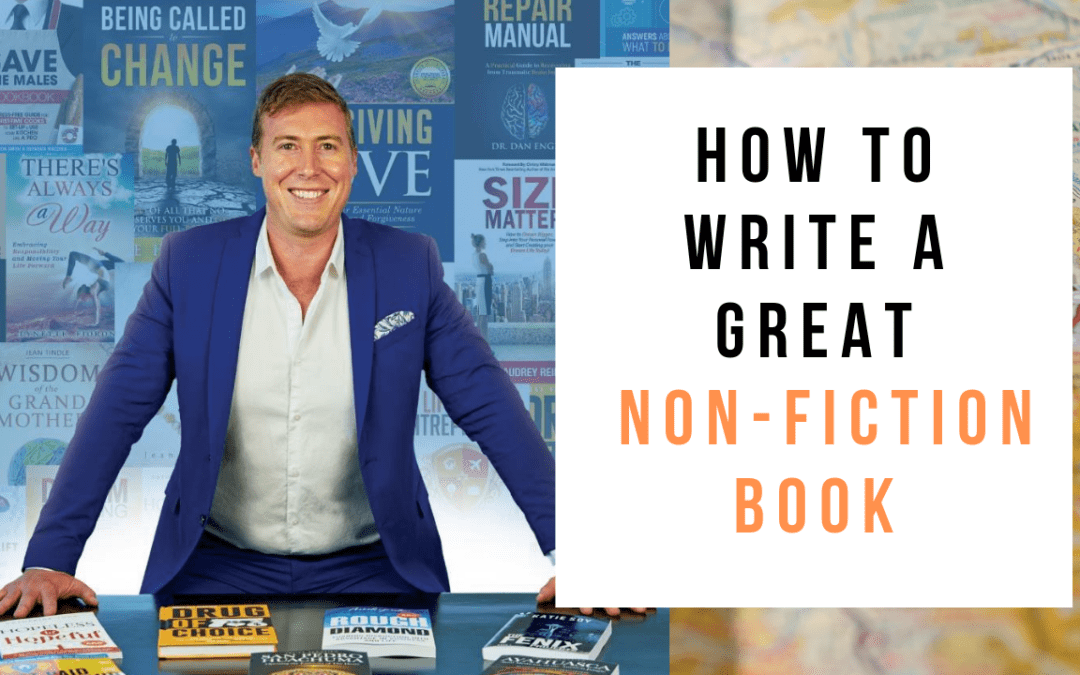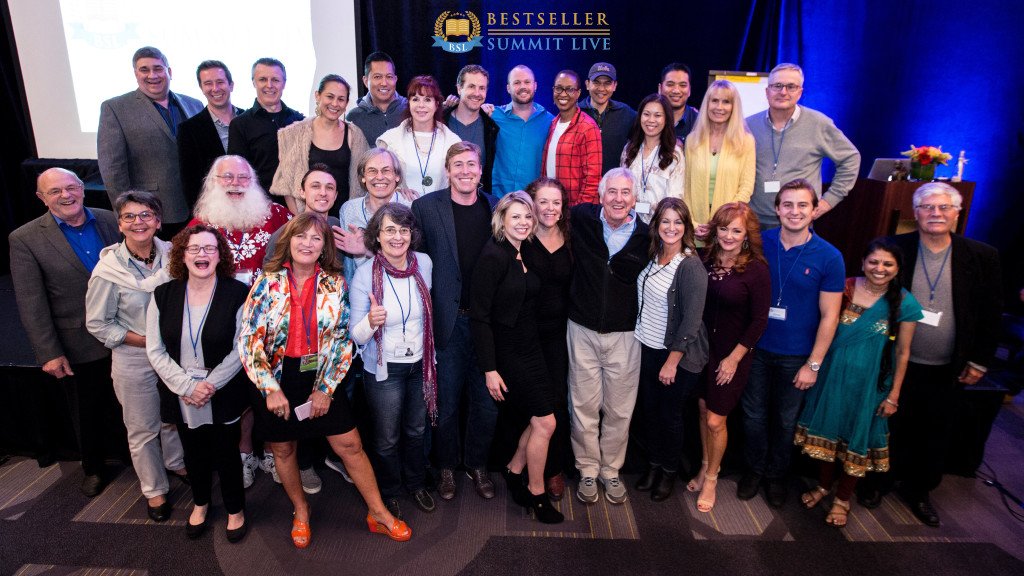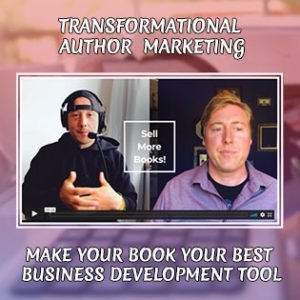
by Jesse Krieger | May 22, 2019 | Author Training, How to Write a Book, Jesse Krieger, Lifestyle Entrepreneurs Press
Vision & Goal Setting for Your Book
Congratulations on deciding to write a book! Honestly, this is an involved undertaking, but writing and publishing a book is one of the most rewarding things you can do in life. Imagine someone you’ve never met, in a place you’ve never been buying and reading your book then telling you the impact your book has made in their life. Think about how that will feel and really see it in your mind’s eye. That is where you are going and I can tell you from deep personal experience that it feels amazing!
Creating a vision and setting goals for your book at the outset is incredibly valuable and will save you the time and frustration borne from writing without a plan. The big picture vision for your book should include how it will play into the next level of growing (or launching) your business and brand.
Strategic Planning For Your Book Launch & Beyond – To get you started writing the right way I created a video for you:
=> Download Strategic Planning Worksheet Here
By taking just a little time to create a big vision and a high-level strategic plan, you’ll already be further along than most authors who begin writing their book without one.
I’ve created an expanded description of the strategic planning process and how to create a compelling vision for your book in this post: Create a Big Vision and Set Goals for Your Book (coming soon)
Creating an Outline & Structuring Your Content
Now that you have clarity on the overarching vision for your book, let’s dive into creating an outline and structuring your content so your book makes a big impact on your readers. To get clear on how your book should flow and what content should go where, consider this question:
“From the moment someone starts reading the first page, to the moment they finish the last sentence, what has changed in your reader’s life?”
What new perspective does he have? How is she thinking about the topic differently now than before? What have they learned, discovered, or solved in their life after having read your book.
This line of questioning starts to clarify the transformation that will take place in your reader’s life as a result of reading your book. Thinking of it through the reader’s perspective is super helpful to “get out of your own way” and really focus on what information, knowledge, wisdom, stories and experience you want to impart to your reader.
How to Write a Book That Transforms Reader’s Lives – This video will help you craft the journey your reader goes on and visualize how their life will be different upon reading your book:
Another way to think about creating an outline and structuring your content is to think through how you already teach or talk about your area of expertise. Do you have a methodology that you developed? Is there a multi-part process that has helped your clients get results? What are the most important things to know about your topic and what is the best order for someone to learn them in?
These questions start to shed light on what the main sections of your book should be and how the chapters could be ordered.
Read this to go deeper: How to Write a Book Outline & Structure Your Content
Write Your Best Content First
It’s time to start writing! (…aka, holy cow what do I write first?!) When you start writing, my best advice is to write your BEST content first. Start writing about what you are most knowledgeable about, most excited to share, that has the most impact for the reader. Dive right into the deep end and get down the most valuable ideas first. You’ll feel an immediate sense of gratification by doing so, and avoid “paralysis by analysis” thinking about how or where to start.
When I wrote Lifestyle Entrepreneur: Live Your Dreams, Ignite Your Passions and Run Your Business from Anywhere in The World the first writing I did was on the actual framework I present on building a virtual business that can be run remotely. This was helpful in the sense that I didn’t spend time thinking about how to introduce myself, or which story to put at the beginning of Chapter 1, all of which is important, but ultimately a prelude to the primary topic the book is about.
You can think of this approach as starting from the inside and working your way out. You write about the thing that made you excited to write a book in the first place and pour yourself into that wholeheartedly. This starts to build momentum fast! Then from the middle, you write your way out to both sides; finishing up the writing process with your Introduction and Conclusion.
“Write your Best Ideas FIRST and Your Introduction LAST”
Build Momentum Writing Your Book
Once you’re past the starting line and have written down the beginnings of your best ideas, you should feel excited and enthusiastic that your book is coming together. Take a moment and appreciate that you are now actually writing a book, instead of talking about writing a book someday. Can you feel the difference?
Now the name of the game is building momentum and getting into a creative flow that will see you through to v1.0 of your manuscript. What I’ve seen countless times is authors start writing because they are passionate about their message and want to build credibility and become a recognized authority with a best-selling book, but worry that it takes too long to write a book and they don’t have the time.
Those are valid concerns, but if we look underneath the surface-level excuses, the real issues that come up during the writing process are of a deeper-seated nature; “Am I even qualified to write a book on this topic?” or “There’s already 20 books on this topic, what do I have to say that people haven’t heard before.” These thoughts and feelings don’t help, but they are just excuses from the ego or previous wounds trying to keep you “safe” by staying the same. Writing a book can drag all the skeletons out of the closet and focus your mind on your shadow instead of facing the light.
That is why it is important to build momentum writing through consistency and staying in touch with your big vision and goals, especially when you’re in the details of bringing your book to life.
No One Regrets Writing a Book (they only wish they started sooner) – Here is a video to motivate you any time you start getting derailed in the writing process:
Writing an Introduction as Your Final Act
As you write through your book and are creating content consistently, you come to a point where you see the light at the end of the tunnel. Yes, writing a book can feel like a never-ending journey, but just keep in mind that is a finite process. There is a beginning, a middle and an end to the process and as long as you keep at it, you’ll eventually get it all out.
Starting writing a book with an outline and a structure in mind is highly recommended, but so it giving yourself permission to call an audible and make adjustments as you’re writing. You have 100% permission to change the order of your book, write a brand new chapter, or remove a whole section of the book that no longer fits the evolving vision. Writing a book really is a balance between structure and planning versus spontaneity and creative flow.
For this reason, it is beneficial to write the Introduction as the final section you create.
A good introduction is a high-level overview of what the reader will learn and experience over the course of the book.
Once the book itself is substantially written, then it becomes easy to simply summarize and present the salient points of what you have just created.
Your Introduction should meet the reader right where they are right now, and paint a picture for how your book is going to get them where they want to be – What they will learn, what problem they will solve, what new technique they will master or what topic they will understand at a deeper level. In terms of meeting the reader where they are right now, think about the person you are writing this book for and what is going on in their head, their life, their business, their relationship right now that has led them to pick up your book. Speak to that from the very first page and you’ll hook their attention right away. From there you can pace their experience as you touch on the main topics, chapters, and ideas they will read about as each page turns.
Read Example Introductions to Best-Selling Non-Fiction Books
Complete Your Manuscript & Finish Your Book
With all of the main content in place, it is time to think about the additional content that, in total, comprises the entirety of your book. Here are some examples of sections additional to the main content in your book that are worth considering before starting the publishing process:
Acknowledgements – Who has been instrumental in you writing this book? Who’s names shall be immortalized in print that you are appreciative of whether or not they were involved in the book at all? This is a great section to spread the love around to the important people in your life and let them know how you feel.
Dedication – Is your book specifically for a a special someone? Are there a few people you would like to dedicate your book to, and what do you want to say to them? Some dedications are short and sweet, others can be a few sentences or even paragraphs. You can dedicate your book to your wife, or your readers, or anyone in between.
Works Cited / Suggested Reading – Does your book need a bibliography to catalog the books and works that made an appearance in your book? Are there specific books you would recommend your readers check out to round out their knowledge on the topic? This section let’s you credit the authors and books that influenced you, and point readers to new books they may enjoy.
Offer Pages – How can people work with you, hire you, or engage you professionally? I highly recommend including a dedicated page for each offer you have available. This could be an online training program, a live event, coaching opportunities or a podcast or blog of yours. Include a URL on each of these pages and consider providing a discount code that incentivizes readers to go further with you (and also lets you attribute new customers and clients to your book)
Celebrate and Prepare to Publish Your Book
Congratulations! You have written a book and that is a BIG accomplishment. Take a moment to reflect back on the journey and appreciate everything you learned in the process. Over 70% of all people say they want to write a book, but less than 1% ever actually do. That means you have leapfrogged everyone else who just talked about it and joined the 1% of authors who wrote an actual book 🙂
Do something to celebrate, and give yourself some time away from your manuscript to regain perspective and refocus on the big picture. The difficult part is behind you now and the next step is to begin the publishing process to bring your book to market. This transition from writing to publishing is where other people begin to get involved and your manuscript transforms to a finished book available to the world at large.
Here is an overview of the publishing process:
Editing – The right time to bring in an editor is once you have a manuscript they can evaluate in it’s entirety. A good editor will give you high-level feedback like how your book is structured, whether you should expand on certain sections, or consider revising other parts of the book, as well as detailed editorial feedback in your manuscript, marking up changes and leaving comments on the text for you to consider.
Cover Design – Your book cover is the first impression readers will have of your book. This is the visual representation of the content you’ve created and it needs to grab readers attention and compel them to pick up or download your book. Although it doesn’t sound nice, the world will judge your book by it’s cover, so invest the time and money to get it professionally designed. Take a survey of other books in your niche and notice what the best-selling books look like. How can yours both fit in as well as stand out?
Interior Design & Layout – This process completes the transformation from a “manuscript” to a “book”. The interior layout creates the reading experience and incorporates decisions like fonts used, illustrations within the text, quotes that are in breakout boxes, and any other design element that complements the text of the book.

by Jesse Krieger | Oct 23, 2018 | Author Training, Jesse Krieger, Lifestyle Entrepreneurs Press
It’s funny how big things started small.
The first time I met Daniel Munro, he wasn’t yet envisioning becoming an author and I wasn’t a publisher.
It was 2012, and Dan was working as a probation officer while using his spare time to study personal development. During his exploration, he picked up a copy of my best-selling book, “Lifestyle Entrepreneur,” and was inspired by the lessons he encountered.
Shortly after reading my book, Dan was driven to do something different — to step outside the rat race.
That “something different” was to write a book conveying many of the ideas and the methodology he’d developed through his own studies.
Dan spent two solid weeks over the Christmas holidays writing the first draft of what would eventually become “The Legendary Life: Build the Motivation and Confidence to Create an Authentic Lifestyle.”
But it wasn’t quite there yet. After sharing his manuscript with a handful of friends and family, they ripped the draft to shreds.
Based on their feedback, he tripled the word count, adding examples, stories, and layers of authenticity to his book.
The goal was to share his knowledge with a wider audience and establish himself as a “confidence coach,” helping others towards the discoveries he’d made himself.
When he finally felt he was ready, he self-published his book to Amazon Kindle. He pushed the “publish” button and the labor of love was met with… crickets.
He sold about five copies …mostly to people he knew.
Dan did some research on publishing with a traditional publisher and even wrote query letters to almost a dozen agents, hoping one would agree to represent him.
Only one responded, and they said no.
Publishing seemed like a closed system — you couldn’t get in unless you were already in. And Dan was securely on the outside — or so he thought.
Because of this, Dan resigned to himself that he’d never be an author, so to speak, but that the book he wrote would be a resource he’d give to his coaching clients.
And then Dan happened to send me a nice email, thanking me for the knowledge that set him on the path to writing his own book and establishing a new career path.
That’s how our relationship began.
I answered quickly, and a correspondence began. Within short order, it came up that Dan had written and self-published a book of his own.
A few more exchanges, and suddenly Dan had a new publisher — Lifestyle Entrepreneurs Press.
Working with Dan was a no-brainer. I had a personal connection with him and our value aligned.
Dan used his book to build a business and Dan used Lifestyle Entrepreneurs Press to raise his profile and reach a larger, international audience with his ideas and message.
Also, the idea of having a physical book, not just an electronic version, was alluring — and something that seemed a distant possibility after his first, failed attempts at getting traction with his self-published book.
Publishing Dan’s book was a collaborative process. I gave Dan an informed expert opinion on elements like design and marketing. But the decision was eventually up to him. I made sure Dan felt in control of the process to the extent he wanted to be.
The result in early 2015?
A polished, professional manuscript published in Kindle and paperback, which has reached #1 status in the Self-Esteem, Psychology & Counseling and Creativity categories of Amazon and continues to bring new clients to Dan month after month.
Dan says he regularly hears from readers who have devoured his book and want to work with him more deeply.
He thinks that having a book helps in several ways:
First, it’s an instant badge of authority that positions himself as a trustworthy expert.
Also, people who have taken the time to read his book and absorb his ideas have already determined whether they’re on board with his program.
The book has been so instrumental in building his coaching business that Dan’s second book, “Nothing to Lose: Using Curiosity to Destroy Hesitation, Procrastination and Limiting Beliefs,” is slated to be published by Lifestyle Entrepreneurs Press this October.
It’s the first in what he plans to be a three-book trilogy, something he couldn’t have imagined a few years ago.
Another benefit of having a bestselling book is the amplification of Dan’s big ideas and messages.
While he may have originally written the book as a way to document his ideas and methodology, he did so with the intent of sharing them with a wider audience.
When asked what he’d say to other aspiring authors, Dan responds that self-publishing successfully is nearly impossible unless you have excellent writing, design and marketing skills — which is rare to find in a single person.
In contrast, the “big” publishing world is closed to anyone without a ready-made platform of tens if not hundreds of thousands.
Don’t let the fears and doubts and blocks that usually hogtie aspiring authors hold you back.
Anyone can be a published author.
If you have the ability to send me an email, you have the ability to write a book.
Pre-order a copy of Dan’s forthcoming book “Nothing to Lose: Using Curiosity to Destroy Hesitation, Procrastination and Limiting Beliefs.”
Meet Daniel Munro and many other inspiring authors at Bestseller Summit Live, October 28-30 in Los Angeles!
Registration closes this week, come join us in LA for the premiere author event of 2016 🙂
To your success,
Jesse

by Jesse Krieger | Nov 4, 2016 | Author Training, Jesse Krieger
One week ago right now I was getting mic’ed up and preparing to hit the stage at Bestseller Summit Live, my annual event for authors and entrepreneurs.
Here are some lessons learned from running this event two years in a row:
1.) It is human nature to wait until the last minute to make a decision.
This characteristic is really on display with live events. Our attendance count more than doubled in the final 8 days before the event as people finalized their plans and definitively decided to come.
This makes planning for events difficult as there is a whirlwind of back-and-forth with the hotel to accommodate the number of guests with seating, food and materials. It can also mess with your head as an organizer as your event can look kind of empty two weeks out…and then BAM the final registration frenzy begins.
2.) There is no replacement for the connections and chemistry of live events.
As someone who has largely built my business and brand online, I can say for sure that there is nothing like being in a room of like-minded individuals to speed up the learning process and make valuable connections.
This is not a knock on virtual summits, webinars or online training programs (I love and utilize them all), but rather a reminder that at the end of the day people value connection and that is a big part of what live events are all about.
3.) Half the value exists within the audience and amongst the attendees.
I told our audience that at least 50% of the value they would get from Bestseller Summit Live would be from the audience members sitting all around them, not from me.
The connections made, collaborations being planned and even co-authoring of books that was initiated at the event proves this is true. So, as an event organizer it’s not about just having 3 days of “killer content” – It’s about fostering those connections and bringing attention to their importance.
If you are interested in publishing with Lifestyle Entrepreneurs Press, please complete this short application and we’ll jump on a complimentary Publishing Consultation.
To your success,
Jesse

by Jesse Krieger | Oct 18, 2016 | Author Training, Jesse Krieger
It’s all a lie.
Whoever told you that you can’t make more as an author is not giving you a complete picture.
With the right strategy, writing a book can become one of the most rewarding and profitable things you can do.
On the other hand, if you don’t apply a proven plan behind your writing career, then you’ll join the ranks of many “starting artists.”
As a published author myself, I’ve seen both ends of the spectrum and I want to shed some light on this topic.
Here are the 3 pillars to become a profitable author.
Pillar #1: Your Book
As an author, your book is the primary vehicle for your message.
This is the tool you’re going to use to transfer your knowledge and experience to the hands of your ideal audience. You can literally give someone years of wisdom in a concise and easy way through your book.
Not only that, having a book is an incredible way to prequalify your clients.
By mentioning different programs, services and other learning opportunities, a portion of your readers will want to take the next step with you.
If they connect with your message, your potential clients will self-select themselves and take the necessary action to get in touch with you.
This makes enrolling clients much easier. It becomes less about you convincing them to work with you and more about them resonating with your story.
Your book positions you as an authority and you become someone people want to do business with.
Pillar #2: Your Business
Your book sparks an idea and gives inspiration to your readers on what’s possible if they implement what they learned in your book.
While your book can definitely make you money, there are other ways to monetize your expertise.
Your readers can go deeper with the subject with an online course and private coaching with you. You can also invite them to a live event or an online summit. You can even charge a premium for a mastermind group where your readers get to learn from you and connect with other like-minded people.
Having these options in the backend make your book a much more compelling business model. The options are limitless.
Ultimately, your business should fulfill the promise you made in the book. Make it real and give your readers the A-to-Z, step-by-step process to help them achieve their ideal outcome.
Pillar #3: Your Brand
One of the best aspects about publishing a book is getting inbound media opportunities.
If you provide a way for people to contact you, you can reasonably expect to get invited in different forms of media.
People can submit a short form on your website requesting a consultation or invite you to be a guest on a podcast, expert on an online summit and even a speaker on live events.
Once you have traction in the media, you can use that as leverage to make an appearance on bigger shows.
Whether you want to be on TV, on the radio or on stage, a book is a great credibility builder. Not only will it help expand your audience, it will also allow you to inspire people around the globe.

Bestseller Summit Live
If you’re ready to finally get that book out of your head, into the world and onto the best-seller charts, then you need to come to Bestseller Summit Live, October 28-30 in Los Angeles.
Click here to learn more and register.

by Jesse Krieger | Oct 18, 2016 | Author Training, Jesse Krieger
There’s no way around it.
Unless, you’re able to overcome the mental blocks that prevent you from writing your book, your dreams of becoming a best selling author will remain… a dream.
After publishing multiple best selling books, I’ve talked to a lot of first time authors along the way.
They seem to have the same internal issues that they struggle to overcome.
They doubt themselves and have limiting beliefs that hold them back.
I can totally relate to these. I’ve encountered myths, limiting beliefs and doubts throughout my journey as well.
That’s why I’m here to help.
Here are 5 myths that hold first time authors back from writing their book and how to overcome them.
Myth #1 – I’m Not An Expert
This one of the most common myths I hear all the time.
But the truth is, most people don’t really care what your credentials are.
You don’t need to be an expert to write a book. You just need to solve an urgent problem for a specific group of people.
What’s more important than your credentials is how you deliver the information.
People like to do business with other people they like. The more personal stories you share, the more your readers will be able to relate to you.
You just have to be a curator of good information. Take the best advice out there on your particular subject and add your personal experiences.
Your ability to provide real value to your readers is more important than being an expert.
Myth #2 – I’m Not A Good Writer
If English wasn’t your best class back in school, don’t worry about it.
In fact, I want you to forget everything you learned about writing. A book isn’t about a collection of facts and data. That would be really boring and you might put your readers to sleep.
The best books out there are conversational. It feels like your reader is just having a conversation right in front of you.
You don’t need to be a great writer to become a best selling author.
In fact, you don’t even need to write your book. You can have someone interview you and transcribe the recoding. Think of yourself more as a storyteller rather than a writer.
Not only will this simple process will give you all the content you need for your book, it will also make your writing more engaging to read.
Myth #3 – I Don’t Have Enough Time
We’re all given the same 24 hours per day. How you spend it is what makes the difference.
Most aspiring authors who say they don’t have time to write just means their book is not a big enough priority.
If you truly look at your schedule, I’m confident you can find a few hours here and there to sit down and put words on paper.
If you spend at least 30 minutes a day, you’ll have your book draft done in a month or so.
Remember, writing is just like a muscle. The more you do it, the better you get at it.
Myth 4 – I Don’t Know If People Will Like It
Here’s the reality of your situation: you can’t please everybody.
That statement applies not just to your book but in all areas of your life. You want your book to be appealing to your ideal audience only.
Imagine that you’re writing for one specific person – your perfect customer. And if your message resonates with them then that’s all that matters.
Myth 5 – I Need To Make This Perfect
Don’t let your perfectionism hold you back.
This is by far one of the worst mindset that prevents so many aspiring authors to even get started.
Remember, done is better than perfect. You can always go back and make things better.
Experience is always the best teacher. You’ll learn from about writing and publishing a book from actually doing it than just thinking and talking about it.
Now, I’m not saying put out a crappy book out there. What I’m saying is do the best you could with what you know with the time you have.

Bestseller Summit Live
If you’re ready to finally get that book out of your head, into the world and onto the best seller charts, then you need to come to Bestseller Summit Live, October 28-30 in Los Angeles.
Click here to find out more and register.

by Jesse Krieger | Oct 18, 2016 | Author Training, Jesse Krieger
There’s no doubt about it.
Whether you’re selling a product or a service, having a book is a huge asset for your business. It’s one of the best tools that a lot of world-renowned experts have used to successfully build their brands.
Not only does your book start a conversation with your ideal customers, it also builds trust and credibility very quickly.
As an author, your prospects and peers see you in a more favourable light before they even get in touch with you.
Having a book is an incredible way to attract and persuade your ideal clients to eventually work with you.
There are A LOT of benefits to write a book but for the sake of brevity, we’ll stick with the main ones.
Here are 5 ways authors profit from their book.
1. Passive Income Stream
One of the best things about writing a book is that you can make money from your work in so many different way.
Once you publish your book, you can leverage existing technology and create a simple yet profitable business that will pay you for years to come.
Brands like Amazon, Apple and Google will pay you up to 70% of the sales while promoting you.
That’s pretty crazy, right?
Also, you can profit from your book by publishing it as an e-book, paperback and audiobook as well.
This is a passive income stream because you only have to create it one time and it keeps paying you over and over again.
2. Generate Qualified Leads
In case you didn’t know, Amazon is one of the BIGGEST search engines in the world. And people who visit the site usually have an intention of buying something.
When someone purchases your book, they’ve raised their hand and expressed interests in your topic by voting with their wallet.
Instead of you calling prospects, prospects call you and that’s an entirely different conversation. If they like your book, they’re going to be a lot more likely to invest in your other products or services.
Your book is a great way to build a relationship with your ideal customers before they even get a chance to talk to you. They’re going to be the ones qualifying themselves to work with you which makes the enrolment process much easier.
3. Command Premium Price
The best way to double your business is to double your prices.
If your cost-per-lead and conversation percentages stayed the same, you’ll make more money simply by charging more.
Having a book that positions you as a trusted authority is an effective way to command premium prices.
Why?
Because people want to work with the best. Having a book makes you more reputable almost instantly.
If you want to become a sought-after expert in your field, a book can definitely do that.
4. Free Media Exposure
Writers, reporters and bloggers need good content. They’re always looking for credible sources.
Having a book can make it so much easier for you to get on podcasts, TV shows, radio and even popular blogs.
When you are perceived as an authority in your niche, people start reaching out to you.
If you don’t have a lot of money to spend on your marketing, then a book is the best bang for your buck.
5. Grow Your Network
Your net worth is directly proportional to your network.
If you want to connect with highly influential people in your industry, sending them a copy of your book is a great way to introduce yourself.
Your book becomes a glorified business card.
You’ll get instant respect. Influential people will want to do business with you because you’re a best selling author.
Having a book makes you stand out from the rest very quickly.

Bestseller Summit Live
If you’re ready to finally get that book out of your head, into the world and onto the best seller charts, then you need to come to Bestseller Summit Live, October 28-30 in Los Angeles.
Click here to learn more and register.









